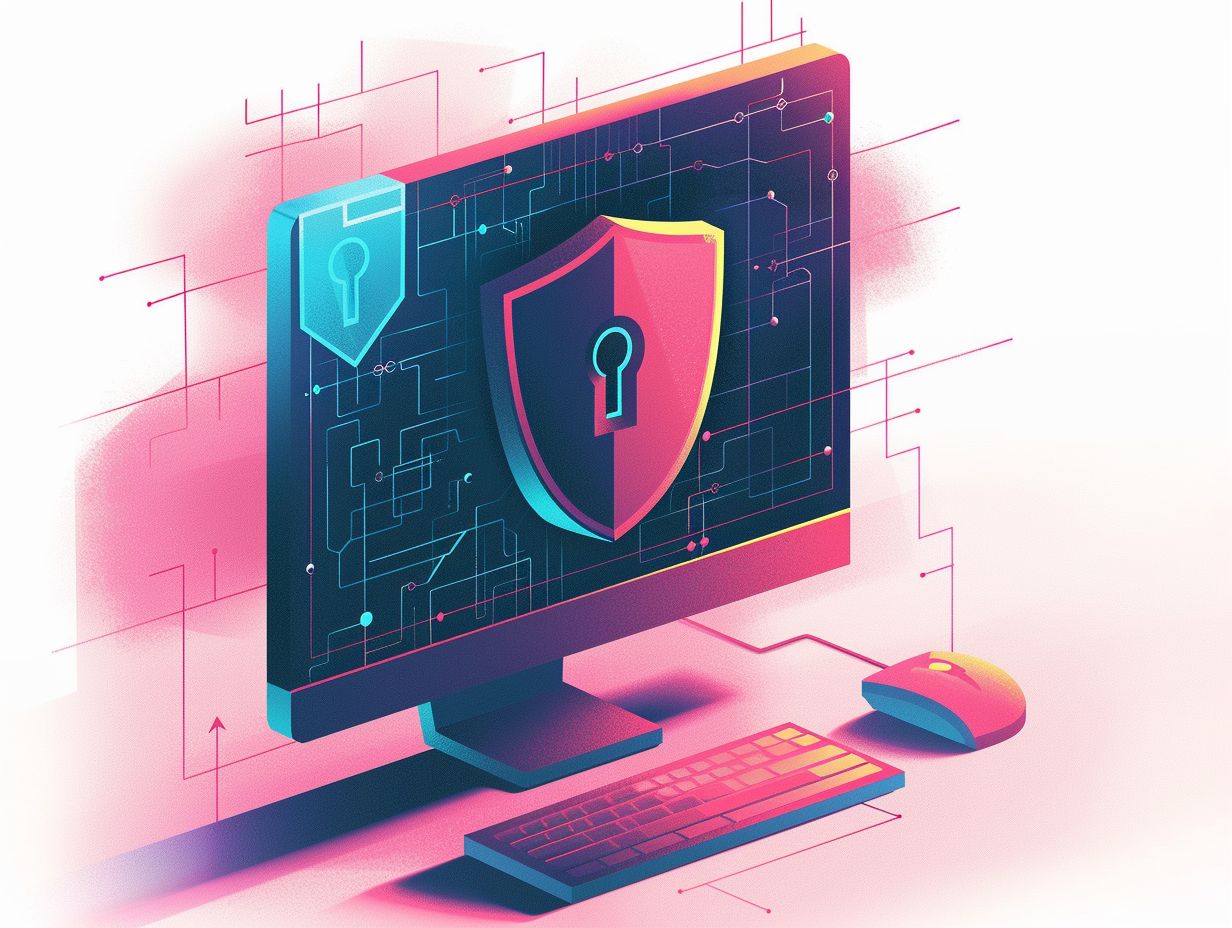The Critical Role Of Automated Patching In Business Cybersecurity

Cybersecurity should be a top priority for businesses of all sizes. One key aspect to consider for maintaining a secure digital environment is automated patching in home cybersecurity.” The discussion covers the definition of automated patching, its benefits, operational mechanisms, and the challenges and constraints associated with its implementation. Additionally, practical recommendations for effectively integrating automated patching are provided.
Key Takeaways

- Automated patching is crucial in protecting businesses from cyber threats and their potential consequences. It helps to proactively address vulnerabilities and reduce the risk of data breaches and financial loss.
- Automated patching is a process of regularly updating and fixing vulnerabilities in software and systems without manual intervention. It offers several advantages for businesses, such as improved security, efficiency, and cost-effectiveness.
- Implementing automated patching requires careful planning and consideration of potential challenges and limitations. Businesses should follow best practices, such as maintaining a schedule and testing patches before deployment, to ensure effective implementation.
The Importance of Cybersecurity for Businesses
Cybersecurity stands as a crucial element, offering protection to organizational data, ensuring adherence to regulatory requirements, and fortifying defenses against vulnerabilities that may expose the business to cyber threats and breaches. In the contemporary interconnected digital sphere, where data is highly prized as a valuable asset for businesses, cybersecurity assumes a pivotal role in preserving the confidence of both customers and stakeholders. A robust cybersecurity framework not only serves to shield sensitive information from unauthorized access but also aids in maintaining compliance with standards established by regulatory bodies. Through the implementation of effective cybersecurity protocols, organizations can diminish the potential risks posed by cyberattacks, uphold their reputation, and guarantee the seamless continuity of their business functions.
Understanding the Risks and Consequences
Understanding the risks and consequences of cybersecurity breaches is essential for businesses to grasp the potential impact of cyber threats and exploits on operations and data security. Cybersecurity vulnerabilities can expose sensitive business information to unauthorized access, leading to data breaches that can result in financial losses, damaged reputation, and legal repercussions. Cyber attacks, such as ransomware or phishing, pose significant threats by disrupting operations, stealing intellectual property, or causing network outages. Failing to address these vulnerabilities adequately may result in non-compliance with data protection regulations, risking fines and loss of customer trust. Real-world examples like the Equifax data breach or the WannaCry ransomware attack highlight the devastating effects cyber threats can have on businesses of all sizes.
The Role of Automated Patching in Cybersecurity
Automated patching plays a critical role in enhancing cybersecurity by efficiently addressing vulnerabilities in software systems through automated patch management processes. This method automates the process of detecting, testing, and deploying patches across an organization’s network, significantly reducing the manual effort and human error associated with patching. By automating these tasks, organizations can ensure that their systems remain consistently updated with the latest security patches, thereby increasing the difficulty for cyber attackers to exploit known vulnerabilities. This proactive approach to patch management not only bolsters the overall security posture of an organization but also reduces the window of opportunity for potential cyber threats to compromise sensitive data or disrupt operations.
What is Automated Patching?
 Automated patching refers to the process of automatically applying software updates and patches to systems to address known vulnerabilities and enhance overall security. By utilizing automated patching, organizations can streamline patch management processes by proactively identifying and remediating security flaws without manual intervention. This technology works by scanning software for missing patches, downloading and deploying updates, and verifying successful installations. Automated patching plays a crucial role in maintaining system integrity by ensuring that critical security updates are applied promptly, reducing the window of opportunity for potential cyber attacks. Not only does it enhance defense mechanisms, but it also minimizes downtime and operational disruptions caused by security incidents. Some popular automated patching tools include Microsoft’s Windows Server Update Services (WSUS), IBM BigFix, and SolarWinds Patch Manager.
Automated patching refers to the process of automatically applying software updates and patches to systems to address known vulnerabilities and enhance overall security. By utilizing automated patching, organizations can streamline patch management processes by proactively identifying and remediating security flaws without manual intervention. This technology works by scanning software for missing patches, downloading and deploying updates, and verifying successful installations. Automated patching plays a crucial role in maintaining system integrity by ensuring that critical security updates are applied promptly, reducing the window of opportunity for potential cyber attacks. Not only does it enhance defense mechanisms, but it also minimizes downtime and operational disruptions caused by security incidents. Some popular automated patching tools include Microsoft’s Windows Server Update Services (WSUS), IBM BigFix, and SolarWinds Patch Manager.
Advantages of Automated Patching in Business
Utilizing automated patching can provide your business with several benefits, including increased efficiency, a stronger cybersecurity posture, and proactive management of vulnerabilities. By implementing automation in the patching process for software and systems, organizations can decrease manual labor and human error, resulting in smoother operations and reduced downtime. This streamlined approach not only strengthens overall security measures but also ensures timely application of critical patches, minimizing exposure to potential threats. Automated patching is a key component in risk mitigation as it lowers the risk of security breaches stemming from unpatched vulnerabilities. Companies that have integrated automated patching solutions have reported notable cost savings and improved compliance adherence, showcasing its positive impact on security and financial aspects alike.
How Automated Patching Works
Automated patching functions by utilizing centralized management tools to identify, deploy, and monitor software updates across systems. This approach ensures that patch management is conducted in a timely manner, enhancing the security of systems. These centralized management tools streamline the process of detecting vulnerabilities, deploying patches, and monitoring system security. By minimizing manual intervention, this process leads to increased efficiency and a more consistent patching schedule. Centralized patch management offers system-wide visibility and control, allowing organizations to promptly address vulnerabilities and improve the overall security posture of their digital infrastructure.
Step-by-Step Process
The step-by-step process of automated patching involves identifying vulnerabilities, prioritizing patches, deploying updates, and verifying successful patch implementation to ensure system security.
- Identify vulnerabilities through regular scans and assessments.
- Prioritize patches based on criticality, evaluating the potential impact on system security and functionality.
- Deploy patches following a structured schedule to minimize downtime and disruptions.
- Validate the effectiveness of each patch through rigorous testing to ensure they do not introduce new issues or conflicts.
- Continuous monitoring mechanisms provide real-time insights into system health and alert you to potential breaches or vulnerabilities that require immediate attention.
Challenges and Limitations of Automated Patching
 Despite its benefits, automated patching faces challenges and limitations related to system compatibility, patch validation, and potential disruptions that you must address to optimize its effectiveness. One common challenge in automated patching practices is the occurrence of patch conflicts, where multiple patches may interfere with each other or cause unintended consequences. This can lead to system instability and even downtime if not handled properly. You may struggle with the time-consuming task of thoroughly testing patches before deployment to ensure they do not introduce new vulnerabilities. By implementing risk assessment protocols, setting up robust backup procedures, and creating contingency plans, you can mitigate these challenges and streamline your automated patching processes.
Despite its benefits, automated patching faces challenges and limitations related to system compatibility, patch validation, and potential disruptions that you must address to optimize its effectiveness. One common challenge in automated patching practices is the occurrence of patch conflicts, where multiple patches may interfere with each other or cause unintended consequences. This can lead to system instability and even downtime if not handled properly. You may struggle with the time-consuming task of thoroughly testing patches before deployment to ensure they do not introduce new vulnerabilities. By implementing risk assessment protocols, setting up robust backup procedures, and creating contingency plans, you can mitigate these challenges and streamline your automated patching processes.
Addressing Potential Issues
Addressing potential issues in automated patching requires you to take proactive measures to mitigate risks, optimize patch deployment, and ensure the continuity of cybersecurity measures across systems. This involves implementing a robust risk management strategy that includes regular system assessments to identify vulnerabilities and prioritize patch updates. Continuous monitoring of network traffic and system logs is essential for you to detect any anomalies or suspicious activities that may indicate a potential security breach. In addition, having proactive incident response plans in place enables organizations to swiftly respond to and contain any cybersecurity incidents that may arise during automated patching processes. Incorporating feedback mechanisms and lessons learned from past incidents, you can enhance the effectiveness of your automated patching solutions and adapt to evolving cyber threats more effectively.
Best Practices for Implementing Automated Patching
Implementing automated patching best practices is essential for your organization to maximize the benefits of proactive vulnerability management, optimize system security, and enhance overall cybersecurity resilience. Automated patching tools streamline the patch management process by automating detection, assessment, and deployment of patches. When prioritizing patches, factors such as severity level, exploitability, and potential impact on the system should be considered. Testing methodologies, including staging environments and automated testing scripts, help ensure that patches are properly assessed before deployment. Deployment strategies should be well-planned, with scheduled maintenance windows and rollback plans in case of unexpected issues. Post-implementation monitoring is vital for detecting anomalies or performance issues after patch deployment, allowing for quick remediation. Continuous improvement in automated patching practices involves regular review of policies, tool efficacy, and integration with existing IT frameworks to adapt to evolving threats and vulnerabilities.
Tips for Effective Implementation
Effective implementation of automated patching requires strategic planning, stakeholder involvement, and ongoing evaluation to ensure seamless integration, optimal system performance, and enhanced cybersecurity resilience. Engaging stakeholders early in the process is crucial for gaining buy-in and support across different departments. Allocating sufficient resources, both in terms of budget and skilled personnel, is essential for successfully automating patch management. To measure the efficiency of automated patching, organizations can establish key performance metrics such as patch deployment times and vulnerability resolution rates. Regular audits help identify potential gaps or areas for improvement. Adapting to evolving cybersecurity threats by staying informed about industry trends and best practices is vital for maintaining a proactive patch management strategy.
Frequently Asked Questions

What is the critical role of automated patching in business cybersecurity?
The critical role of automated patching in business cybersecurity is to ensure that all software and systems are up-to-date with the latest security patches, reducing the risk of potential vulnerabilities being exploited by cyberattacks.
Why is automated patching important for businesses?
Automated patching is important for businesses because it helps to prevent cyberattacks and data breaches by regularly updating software and systems with the latest security patches. This helps to keep sensitive information and customer data safe.
How does automated patching improve the efficiency of cybersecurity measures in businesses?
Automated patching improves the efficiency of cybersecurity measures in businesses by reducing the time and effort required to manually patch software and systems. This allows IT teams to focus on other important tasks and ensures that all devices are consistently and uniformly patched.
What are the potential risks of not implementing automated patching in business cybersecurity?
Not implementing automated patching in business cybersecurity can leave the company vulnerable to cyberattacks and data breaches. Outdated software and systems are easy targets for hackers and can result in financial losses, reputational damage, and legal consequences.
How does automated patching help with compliance and regulatory requirements?
Automated patching helps with compliance and regulatory requirements by ensuring that all software and systems are up-to-date with the latest security patches. This is crucial for meeting data protection standards and avoiding penalties for non-compliance.
Is automated patching a one-time process or an ongoing process?
Automated patching is an ongoing process. It is important for businesses to regularly schedule and conduct patching to stay protected against emerging threats and vulnerabilities. This ensures that all systems and software are consistently updated and secured.









